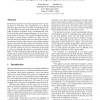Free Online Productivity Tools
i2Speak
i2Symbol
i2OCR
iTex2Img
iWeb2Print
iWeb2Shot
i2Type
iPdf2Split
iPdf2Merge
i2Bopomofo
i2Arabic
i2Style
i2Image
i2PDF
iLatex2Rtf
Sci2ools
IROS
2006
IEEE
2006
IEEE
Surface Recognition by Registering Data Curves from Touch
Model-based recognition of an object typically involves matching dense 3D range data. The computational cost is directly affected by the amount of data of which a transformation needs to be found before carrying out the match against a model. This paper investigates recognition using “one-dimensional” data, more specifically, points sampled along three concurrent curves on the surface of an object. The introduced method determines the quality of match against a model in two steps. First, the Gaussian and mean curvatures at the curve intersection point are estimated and used in a table lookup to find multiple candidate points on the model that have similar local geometry. Second, starting at each point, local optimization is conducted to search for a possible location of the curve intersection on the model as well as an orientation that leads to a good match of all data points. The best match between the model and the data curves is chosen over the results obtained from all candi...
Candidate Points | Curve Intersection | IROS 2006 | Match | Robotics |
| Added | 12 Jun 2010 |
| Updated | 12 Jun 2010 |
| Type | Conference |
| Year | 2006 |
| Where | IROS |
| Authors | Rinat Ibrayev, Yan-Bin Jia |
Comments (0)

